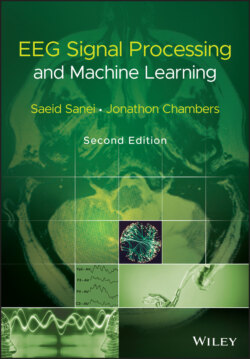Читать книгу EEG Signal Processing and Machine Learning - Saeid Sanei - Страница 12
List of Abbreviations
Оглавление3DThree‐dimensionalAASMAmerican Academic of Sleep MedicineACCAnterior cingulate cortexACEAddenbrooke’s cognitive examinationACRAccuracy of responsesACTAdaptive chirplet transformADAlzheimer’s diseaseADCAnalogue‐to‐digital converterADDAD patients with mild dementiaADDAttention‐deficit disorderADHDAttention‐deficit hyperactivity disorderAEApproximate entropyAEAutoencoderAEPAudio evoked potentialsAfCAffective computingAg–AgClSilver–silver chlorideAIArtificial intelligenceAICAkaike information criterionALEAdaptive line enhancerALFAdaptive standardized LORETA/FOCUSSALMAugmented Lagrange multipliers methodALSAlternating least squaresALSAmyotrophic lateral sclerosisAMDFAverage magnitude difference functionAMIAverage mutual informationAMMAugmented mixing matrixANNArtificial neural networkAODAuditory oddballAPAction potentialApEnApproximate entropyAPGARCHAsymmetric power GARCHARAutoregressive modellingARMAAutoregressive moving averageASCOTAdaptive slope of wavelet coefficient counts over various thresholdsASDAutism spectrum disorderASDAAmerican Sleep Disorders AssociationAsIAsymmetry indexASRAutomatic speaker recognitionASSAverage artefact subtractionAUCArea under the curveBASBehavioural activation systemBBCIBerlin BCIBBIBrain‐to‐brain interfaceBCGBallistocardiogramBCIBrain–computer interfacingBDSBrock, Dechert, and ScheinkmanBEMBoundary‐element methodBFBeamformerBGDBootstrapped geometric differenceBICBayesian information criterionBISBehavioural inhibition systemBISBispectral indexBMIBrain–machine interfacingBOLDBlood oxygenation level dependentBPBereitschaftspotentialBPBipolar disorderBrain/MINDSBrain Mapping by Integrated Neurotechnologies for Disease StudiesBSEBlind source extractionBSRBurst‐suppression ratioBSSBlind source separationbvFTDBehaviour variant frontotemporal dementiaCaCalciumCAEContractive autoencoderCANDECOMPCanonical decompositionCBDCorticobasal degenerationCBFCerebral blood flowCCACanonical correlation analysisCEEMDANComplete ensemble EMD with adaptive noiseCFCharacteristic functionCFCognitive fluctuationCFSChronic fatigue syndromeClChlorideCDLSACoupled dictionary learning with sparse approximationCDRCurrent distributed‐source reconstructionCICovariance intersectioncICAConstrained ICACITConcealed information testCJDCreutzfeldt–Jakob diseaseCMACircumplex model of affectsCMTFCoupled matrix and tensor factorizationsCMOSComplementary metal oxide semiconductorCNNConvolutional neural networkCNSCentral nervous systemCORCONDIACore consistency diagnosticCoSAMPCompressive sampling matching pursuitCPSCyber‐physical systemsCRBPFConstrained Rao‐Blackwellised particle filterCSACentral sleep apnoeaCSDCurrent source densityCSFCerebrospinal fluidCSPCommon spatial patternsCTComputerized tomographyDAEDenoising autoencoderDARPADefence Advanced Research Projects AgencyDASMDifferential asymmetryDBSDeep brain stimulationDCDirect currentDCAUDifferential CausalityDCMDynamic causal modellingDCTDiscrete cosine transformdDTFDirect directed transfer functionDEDifferential entropyDeconvNetDeconvolutional ANNDFTDiscrete Fourier transformDFVDominant frequency variabilityDHTDiscrete Hermite transformDLDiagonal loadingDLEDigitally linked earsDMDefault modeDMNDefault mode networkDNNDeep neural networkDPFDifferential pathlength factorDSMDiagnostic and Statistical ManualDSTCLNDeep spatio‐temporal convolutional bidirectional long short‐term memory networkDTDecision treeDTFDirected transfer functionDTIDiffusion tensor imagingDUETDegenerate unmixing estimation techniqueDWTDiscrete wavelet transformECDElectric current dipoleECDEquivalent current dipoleECGElectrocardiogramECGElectrocardiographyECoGElectrocorticogramECTElectroconvulsive therapyEDError distanceEEGElectroencephalogramEEGElectroencephalographyEEMDEnsemble empirical mode decompositionEGARCHExponential GARCHEGGElectrogastrographyEKGElectrocardiogramEKGElectrocardiographyEMExpectation maximizationEMDEmpirical mode decompositionEMGElectromyogramEMGElectromyographyENetEfficient neural networkEOGElectro‐oculogramEPEvoked potentialEPNEarly posterior negativityEPSPExcitatory post‐synaptic potentialERBMEntropy rate bound minimizationERDEvent‐related desynchronizationERNError‐related negativityERPEvent‐related potentialERSEvent‐related synchronizationFAFactor analysisFCFunctional connectivityFCMFuzzy c‐meansFDFractal dimensionFDAFood and Drug AdministrationFDispEnFluctuation‐based dispersion entropyFDRFalse detection rateFEMFinite element modelFFNNFeed forward neural networkFETField‐effect transistorfICAFast independent component analysisFIRFinite impulse responsefMRIFunctional magnetic resonance imagingFMSFibromyalgia syndromeFNFalse negativefNIRSFunctional near‐infrared spectroscopyFOForamen ovaleFOBSSFirst order blind source separationFOCUSSFocal underdetermined system solverFOOBIFourth order cumulant based blind identificationFPFalse positiveFRDAFrontal rhythmic delta activityFRNFeedback related negativityFSORFeature selection with orthogonal regressionFSPFalsely detected source number (position)FTDFrontotemporal dementiaFuzEnFuzzy entropyGAGenetic algorithmGADGeneral anxiety disorderGANGenerative adversarial networkGARCHGeneralized autoregressive conditional heteroskedasticityGARCH‐MGARCH‐in‐meanGCGranger causalityGCNGraph convolutional networkGFNNGlobal false nearest neighboursGJR‐GARCHGlosten, Jagannathan, & Runkle GARCHGLMGeneral linear modelGMMGaussian mixture modelGPGaussian processGP‐LRGaussian process logistic regressionGSCCAGroup sparse canonical correlation analysisGSRGalvanic skin responseGWNGaussian white noiseHBO/HbOOxyhaemoglobinHBR/HbRDe‐oxyhaemoglobinHBTTotal haemoglobinHCIHuman computer interactionHDHuntington’s diseaseHEOGHorizontal electro‐oculographHFDHiguchi's fractal dimensionHHTHilbert–Huang transformHMDHead‐mounted displayHMMHidden Markov modelHOPLSHigher‐order partial least squaresHOSHigher‐order statisticsHRHemodynamic responseHRFHaemodynamic response functionHTHilbert transformIAPSInternational affective picture systemIBEInternational Bureau for EpilepsyICIndependent componentICAIndependent component analysisiCOHImaginary part of coherencyIEDInterictal epileptiform dischargeiEEGIntracranial electroencephalogramICAIndependent component analysisIIRInfinite impulse responseILAEInternational League Against EpilepsyIMFIntrinsic mode functionImSCohImaginary part of S‐coherencyINDSCALINDividual Differences SCALingIoBInternet‐of‐brainsIPLInferior parietal lobuleIPSPInhibitory post‐synaptic potentialIRImpulse responseIRLSIterative recursive least squaresISODATAIterative self‐organizing data analysis technique algorithmIsomapIsometric mappingISSWTInverse synchro‐squeezing wavelet transformITRInformation transfer rateIVEImmersive virtual environmentsJADJoint approximate diagonalizationJADEJoint approximate diagonalization of eigenmatricesjICAJoint ICAKPotassiumKcKolmogorov complexityKDTKarolinska drowsiness testKLKullback–LeiblerKLTKarhunen–Loéve transformKMIKinaesthetic motor imageryKNNk‐nearest neighbourKPCAKernel principal component analysisKSSKarolinska sleepiness scaleKTKuhn–TuckerLBDLewy body dementiaLCMVLinearly constrained minimum varianceLDLinear discriminantsLDLinearly distributedLDALinear discriminant analysisLDALong delta activityLELyapunov exponentLEMLocal EEG modelLLELargest Lyapunov exponentLMSLeast mean squareLORETALow‐resolution electromagnetic tomography algorithmLPLowpassLPMLetters per minuteLPPLate positive potentialLRCNLong‐term recurrent convolutional networkLRTLow‐resolution tomographyLSLeast squaresLSELeast‐squares errorLSTMLong short‐term memory networkLVQLearning vector quantizationLWRLevinson–Wiggins–RobinsonLZCLempel–Ziv complexityM2MMachine‐to‐machineMAMental arithmeticMAMoving averageMAFMultivariate ambiguity functionMAPMaximum a posterioriMCIMild cognitive impairmentMCMCMarkov chain Monte CarloMDIMultidimensional directed informationMDPMoving dipoleMEGMagnetoencephalogramMFDEMultiscale fluctuation‐based dispersion entropymHTTMutant huntingtinMIMutual informationMILMatrix inversion lemmaMLMaximum likelihoodMLEMaximum likelihood estimationMLEMaximum Lyapunov exponentMLPMultilayer perceptronMMNMismatch negativityMMSEMinimum mean squared errorMNIMontreal Neurological Institute and HospitalMNLSMinimum norm least squaresMPMatching pursuitsMRIMagnetic resonance imagingMRPMovement‐related potentialMSEMultiple system atrophyMSEMean squared errorMSEMultiscale entropyMSMultiple sclerosisMTLEMesial temporal lobe epilepsyMUSICMultichannel signal classificationMVARMultivariate autoregressiveNaSodiumNCNormal controlNCDFNormal cumulative distribution functionNCSPNonparametric common spatial patternsNDDNeurodevelopmental disorderNESNonepileptic seizureNIHNational Institute of HealthNIRNear infraredNIRSNear‐infrared spectroscopyNLMSNormalized least mean squareNMFNonnegative matrix factorizationNMCSPNonparametric multiclass common spatial patternsNMRNuclear magnetic resonanceNNNeural networkNNQPNonnegative quadratic programNPNeural processNREMNon‐rapid eye movementNSINonstationary indexOAOcular artefactOBSOptimal basis setOBSOrganic brain syndromeOFCOrbital frontal cortexOMPOrthogonal matching pursuitOPOddball paradigmOSAObstructive sleep apnoeaOSAHSObstructive sleep apnoea hypopnea syndromePARAFACParallel factor analysisPCAPrincipal component analysisPCANetPrincipal component analysis networkPCCPearson product correlation coefficientPCCPosterior cingulate corticesPDParkinson’s diseasePDCPartial directed coherencepdfProbability density functionPeError positivityPerEnPermutation entropyPETPositron emission tomographyPFParticle filterPFCPrefrontal cortexPICPower iteration clusteringPIFPhase interaction functionPLEDPeriodic literalized epileptiform dischargesPLIPhase lag indexPLMDPeriodic limb movement disorderPLSPartial least squaresPMBRPost‐movement beta reboundPMBSPost‐movement beta synchronizationPNRDNonrhythmic delta activityPOSTPositive occipital sharp transientsPPCPhase–phase couplingPPGPhotoplethysmographyPPMPiecewise Prony methodPSDPower spectrum densityPSDMPhase‐space dissimilarity measuresPSGPolysomnographyPSIPhase‐slope indexPSPPost‐synaptic potentialPSPProgressive supranuclear palsyPSWCPeriodic sharp wave complexesPTSDPost‐traumatic stress disorderPWVDPseudo‐Wigner–Ville distributionQEEGQuantitative EEGQGARCHQuadratic GARCHQNNQuantum neural networksQPQuadratic programmingR&KRechtschtschaffen and KalesRAPRecursively applied and projectedRASMRational asymmetryRBDREM sleep behaviour disorderRBFRadial basis functionRBPFRao‐Blackwellised particle filterRBRRelative beta ratioRCERecursive channel eliminationRERegional entropyReLURectified linear unitREMRapid eye movementRFRadio frequencyRFNNRecurrent fuzzy neural networkRKHSReproducing kernel Hilbert spacesRLSRecursive least squaresRMBFRobust minimum variance beamformerRMSRoot mean squareRNNRecurrent neural networkROCReceiver operating characteristicRPReadiness potentialRRRespiratory rateRTReaction timerTMSrepetitive transcranial magnetic stimulationRVResidual varianceSAEStacked autoencoderSampEnSample entropySASSleep apnoea syndromeSCASparse component analysisSCDSickle cell diseaseSCPSlow cortical potentialSCPSSlow cortical potential shiftSCRSkin conductance responseSCVSpectral coherence valueSCWTStroop colour and word testSDAEStacked denoising autoencoderSDTFShort‐time DTFSEMStructural equation modellingSFSSyncFastSlowSGSensory gatingSISynchronization indexSICASpatial ICASLSynchronization likelihoodsLORETAStandardized LORETASLTPShort‐ and long‐term predictionSMISample‐matrix inversionSMlSensorimotor leftSMOTESynthetic minority oversampling techniquesMRIStructural MRISNSalient networkSNNSpike neural networkSNNAPSimulator for Neural Networks and Action PotentialsSNRSignal‐to‐noise ratioSOBISecond‐order blind identificationSOBIUMSecond‐order blind identification of underdetermined mixturesSPETSingle photon emission tomographySPMStatistical parametric mappingSPQSchizotypal personality questionnaireSREDASubclinical rhythmic EEG discharges of adultsSRNNSleep EEG recognition neural networkSSASingular spectrum analysisSSLOFOShrinking standard LORETA‐FOCUSSSSPESubacute sclerosing panencephalitisSSVEPSteady‐state visual evoked potentialSSVERSteady‐state visual evoked responseSSWTSynchro‐squeezing wavelet transformSTFSpace–time–frequencySTFDSpatial time–frequency distributionSTFTShort time–frequency transformSTLShort‐term largest Lyapunov exponentSTSSuperior temporal sulcusSVSupport vectorsSVDSingular‐value decompositionSVMSupport vector machinesSVRSupport vector regressionSWASlow‐wave activitySWDAStep‐wise discriminant analysisSWSlow waveSWPSlow‐wave powerSWSSlow‐wave sleepTBITraumatic brain injuryTDNNTime delay neural networkTDOATime difference of arrivalTDP‐43Transactive response DNA‐binding protein 43 kDaTENSTranscutaneous electrical nerve stimulationTFTime–frequencyTGARCHThreshold GARCH modelTICATemporal ICATISTMS induction simulatorTLETemporal lobe epilepsyTMSTranscranial magnetic stimulationTNTrue negativeTNMTraditional nonlinear methodTOATime of arrivalTotHbTotal haemoglobinTPTrue positiveTRRepeat timeTSSATensor‐based singular spectrum analysisTTDThought translation deviceUBIUnderdetermined blind identificationUOMUnderdetermined orthogonal modelUSPUndetected source numberUSRUnderdetermined source recoveryVAEVariational autoencoderVEOGVertical electro‐oculographVEPVisual evoked potentialVLSIVery large‐scale integratedvMPFCVentral medial prefrontal corticesVPPVertex positive peakVRVirtual realityWAWald tests on amplitudesWCWord chainWCOWeakly coupled oscillatorWDCWeighted degree centralityWLWald test on locationsWMNWeighted minimum normWNWavelet networkWPEWavelet packet energywPLIWeighted phase lag indexwSMIWeighted symbolic mutual informationWTWavelet transformWUWeighted undersamplingWVWigner–Ville
